Brands now need specialised LLM tracking tools to monitor and improve how often they’re mentioned in AI-generated answers on platforms like ChatGPT and Bard, since traditional SEO tools don’t cover this. The space is exploding with dozens of options, each offering features like multi-platform tracking, sentiment analysis, and actionable insights. There’s no single “best” tool – pick one that fits your needs, test a few, and make AI visibility tracking a standard part of your marketing stack.
As AI chatbots and search assistants become mainstream, brands need new tools to track and optimize their visibility in LLM-generated answers. Dozens of LLM tracking tools – also called AI visibility trackers – have popped up to monitor where and how often your brand is mentioned in AI platforms like ChatGPT, Bard, Bing Chat, Perplexity, and more.
We crowdsourced opinions on LinkedIn after narrowing down a shortlist of five (Peec AI, Profound, Scrunch AI, Trakkr, and Semrush).
The response was overwhelming: marketers shared candid feedback and recommended 20+ other AI brand visibility tracking tools.
Below, we compile the insights and compare the best platforms for tracking LLM-generated brand mentions in 2025 – from focused startups to features in enterprise SEO suites – all to help you effectively track and analyze patterns in AI visibility across multiple AI search platforms.
Why We Need LLM Tracking Tools in 2025
Traditional SEO rank trackers won’t tell you if ChatGPT or Bard is talking about your brand. Large language models don’t just list top-10 links; they rewrite and synthesize information from various sources. Your site could rank #1 on Google yet be ignored by an AI answer engine. This shift has given rise to a new category of tools to track visibility in AI. These tools let you monitor AI-generated references, see which sources the AI cites, and measure your brand’s presence in conversational answers. In other words, an LLM tracker is like an SEO rank tracker for AI chatbots.
The need is pressing. Consumers increasingly turn to AI assistants for search. And if you rely too much on manual checks (typing prompts into ChatGPT and taking screenshots), you won’t capture the whole picture. LLM outputs vary by phrasing, user, and model settings. To track visibility across AI platforms effectively, brands require automated software that can query multiple models, aggregate results, and update over time.
Before tracking, make sure you appear in AI answers.
Schedule a CallOur LinkedIn Experiment: From 5 Tools to 20+ Recommendations
Recently, I posted on LinkedIn that my agency (SaaStorm) had narrowed down five LLM tracking tools for final testing – Peec AI, Profound, Scrunch AI, Trakkr, and Semrush’s AI module. We outlined our key priorities for choosing a solution:
- Multi-domain management: Able to track multiple websites or sub-brands in one platform (critical for agencies and enterprise teams).
- Fair pricing: Reasonable cost or usage-based pricing that scales (some enterprise tools are very expensive).
- Prompt/credit splits: Flexibility in how query credits or prompts are allocated (useful if dividing usage among clients or experiments).
- “Real” ranking data: Accurate, up-to-date data on AI search results (not just static snapshots or guesswork).
- All-in-one capabilities (bonus): A platform that not only tracks AI mentions but also provides optimization tips, content suggestions, or other SEO/LLM optimization features.
The post blew up – over 25,000+ impressions, 100+ reactions and dozens of comments.
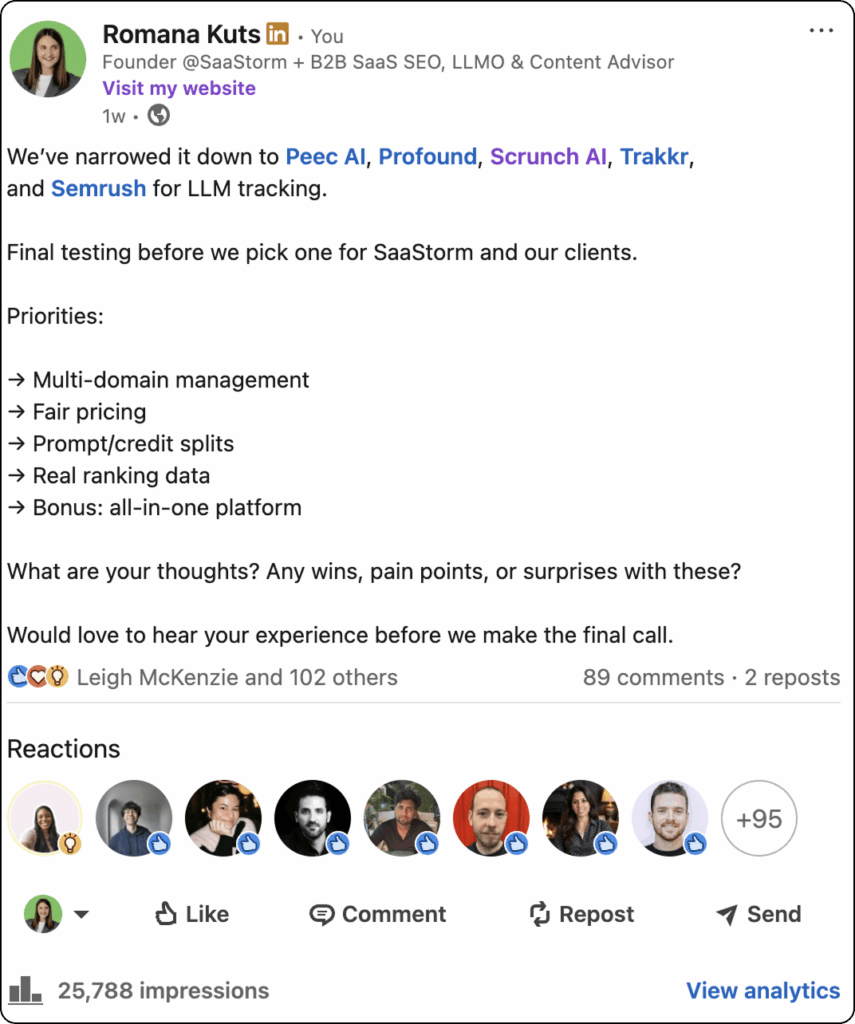
Founders of LLM tracking startups chimed in, and marketers shared their experiences. The consensus was that this is a rapidly evolving space with new entrants every week. “There are so many AI visibility software tools, and even more keep popping up,” one agency CEO remarked. Many have had to demo 10–15 different platforms to find the right fit.
We even had a bit of drama: after hearing the community feedback, we decided to skip a few on our original shortlist and expand our evaluation to some new names. We also discovered additional contenders like AthenaHQ and Azoma targeting enterprise Generative Engine Optimization (GEO), and experimental tools like PromptWatch and Waikay. In short, what began as a shortlist of 5 LLM trackers quickly ballooned into a list of 20+ possible solutions.
So, to make sense of it all, we’ve compiled this guide. It’s part story, part listicle – a journey through the most-mentioned AI brand visibility tracking tools of 2025, along with candid insights from real users.
If you’re asking “how can I track my brand’s AI visibility effectively?”, read on.
What to Look For in an LLM Tracking Tool
Choosing an AI visibility tracker can be daunting when “everyone” claims to be the best. Based on our experience and community input, here are key factors to consider:
- Coverage of Multiple AI Platforms: The tool should track brand visibility across multiple AI platforms – e.g. ChatGPT (various modes), Google’s Search Generative Experience (SGE/Gemini), Bing Chat, Claude, Bard, Perplexity, maybe even niche bots. Coverage matters because each LLM has its own index and behavior.
- Depth of Insights: Basic tracking shows if your brand was mentioned. The better tools go further – showing how it was mentioned (citation, direct answer, or just in a list), which sources were cited for that answer, and even the surrounding context or exact prompt. Advanced platforms offer sentiment analysis of mentions or share of voice metrics (how your brand’s mention frequency compares to competitors). For example, AthenaHQ touts features like competitor analysis and sentiment analysis of AI mentions.
- Data Collection Method: Not all tools gather data the same way. Some use their own prompt scripts and scrape the AI outputs; others use official APIs or even third-party data. This affects reliability. Check if the tool explains its method. Are they sending multiple prompts and averaging results (to reduce randomness)? Are they using real user data streams? This can influence how “real” the ranking data feels.
- Multi-Domain Support: If you manage more than one website or brand, ensure the platform supports multi-domain management under one account. Several commenters noted this as a deal-breaker. Tools like Semrush’s AI tracking and Hall are designed with agencies in mind, allowing easy switching between multiple projects.
- Pricing Model: Pricing varies wildly. Some newer LLM tracking tools have free trials or freemium tiers (e.g. limited keywords per month) to get you in the door, while many enterprise ones require a demo and custom quote. Keep an eye on how they charge – by number of prompts, keywords, or domains tracked. Fair pricing was a top priority for us; a tool can quickly become “expensive monthly subscriptions” (as one SEO leader warned) if it charges per query heavily. Our community flagged Profound as “pretty expensive” for what it offers.
- Actionability: Tracking is step one; knowing what to do with the data is step two. A few platforms differentiate by providing recommendations – e.g. which content to create or optimize to improve visibility, or even generating content tailored for LLMs. Waikay (from the InLinks team) emphasizes actionable “visibility action plans” and AI source analysis. Aiso goes a step further by generating an llms.txt file (analogous to robots.txt, but for LLMs) based on real AI conversations, to help guide bots to your preferred content.
- Scalability & Integrations: If you’re an enterprise, consider if the tool integrates with your workflow – does it have an API, exportable data, or connect to dashboards like Looker/Data Studio? Also, can it handle a large scale of pages or prompts? Some “free beta” tools are great for a small site but might choke on enterprise volumes.
Ultimately, the “best” tool depends on your needs – are you a solo SaaS founder, an agency with 50 clients, or a Fortune 500 brand? Each will weigh the above factors differently. Now, let’s dive into the leading LLM tracking tools and how they stack up.
Not showing up in AI overviews? We’ll get you there.
Schedule a CallTop 23 LLM Tracking Tools for AI Visibility (2025)
Following our LinkedIn post, we gathered a list of prominent platforms to track brand visibility in AI search. Here are the top tools (in no particular order) that B2B marketers and SEO experts are buzzing about, along with their strengths, weaknesses, and any standout commentary from the community.
1. Peec AI – Focused & Affordable AI Search Analytics
Peec AI was one of our initial finalists, and it came recommended for being laser-focused on LLM tracking while remaining affordable. Niklas Buschner shared that his team chose Peec for its focus and value: it was “focused, affordable, and [appeared to have] a good product roadmap” based on job listings he’d seen (a clever way to judge a startup!).
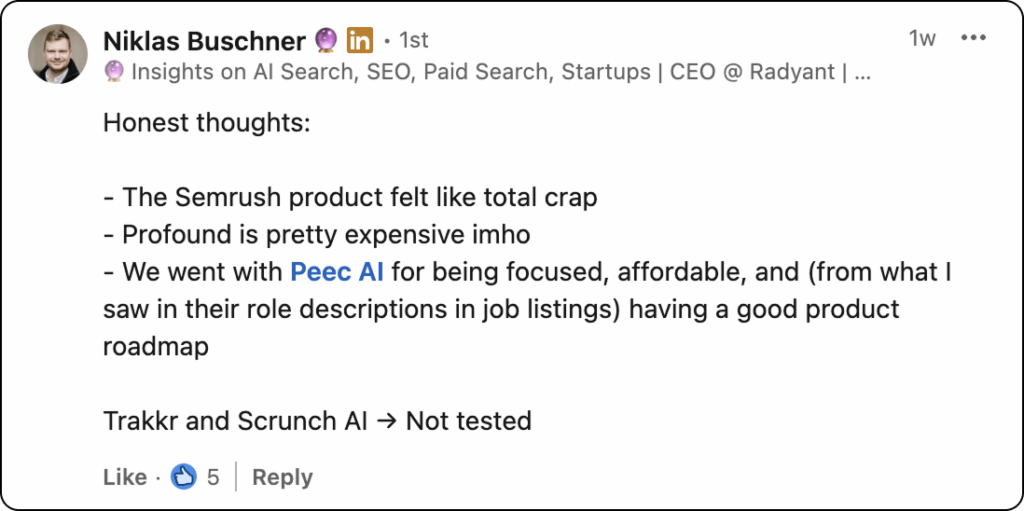
Peec’s tagline is “Analytics for AI search,” and its founder Marius Meiners actively engages with early users (he even commented, happy we were testing Peec).

Key features
Peec tracks how your content appears in AI answers across multiple models. It likely emphasizes clarity and simplicity – giving you a dashboard of where your brand is mentioned in AI results and how often. It may not have as many bells and whistles as enterprise tools, but for many that’s a plus. Multi-LLM support and a reasonable price point make it attractive to startups and agencies on a budget.
Community feedback
Aside from Niklas’s praise, others noted Peec is a newer entrant but evolving quickly. One VC commenter bluntly stated, “I think Peec AI are the best,” which speaks to Peec’s positive buzz. On the flip side, as we broadened our search, Peec didn’t stand out with any unique capabilities beyond solid fundamentals – which is perhaps why we decided to explore further before making a decision.
2. Profound – Enterprise AI Search Visibility Platform
Profound is often mentioned in the same breath as Peec, but it targets a different segment. Profound launched in 2024 with venture funding to tackle enterprise needs in AI search optimization. Its platform offers robust analysis, letting brands see how they appear in common AI queries out-of-the-box and even run custom queries with demographic filters. In essence, Profound aims to be the enterprise dashboard for AI search presence, answering questions like “What does ChatGPT list as the best product in my category?” and “How trustworthy do AI models find my site?”.
Key features
Profound reportedly has strong reporting and analytics. According to one industry roundup, “Profound has the strongest reporting, and they are rapidly adding features like a conversation explorer and bot tracker” to delve deeper into AI responses. It likely tracks multiple AI bots and shows trendlines as the AI algorithms evolve (their cofounder noted the importance of dynamic tracking as LLMs change over time). Profound may also incorporate share of voice or comparison against competitors, given its enterprise focus.
Community feedback
The biggest knock on Profound was cost. “Profound is pretty expensive imho,” said one commenter who ended up choosing a cheaper alternative. Profound often requires a demo and custom pricing – a barrier for smaller teams. However, if budget isn’t an issue, it’s been described as a comprehensive solution for large organizations. It’s a very new company (founded in 2024), some features are still in development – one investor quote in TechCrunch praised the founders’ vision but acknowledged it’s early days. If you need an enterprise AI visibility tracking solution with deep analytics (and have money to spend), Profound is a top contender.




3. Scrunch AI – AI Brand Presence Monitor
Scrunch AI was also on our initial shortlist. Scrunch positions itself as a tool to monitor and optimize brand presence in AI-driven customer journeys. According to an industry “GEO tools” list, “Scrunch AI is a platform designed to help businesses navigate the AI-driven customer journey by optimizing brand presence across various AI search platforms.” It charges around $300/month for its service, squarely targeting businesses that need serious AI monitoring but perhaps aren’t enterprises with custom contracts.
Key features
Scrunch’s feature set appears to cover the basics: tracking multiple AI engines for mentions of your brand or specified keywords, and highlighting where you show up. It likely includes some form of AI bot monitoring and AI traffic monitoring (from the feature checklist in one comparison). The focus seems to be on ensuring your brand is prominent and accurately represented throughout an AI-influenced customer journey – which suggests it might track not just search QA bots but possibly voice assistants or other AI touchpoints.
Community feedback
We didn’t get as much first-hand feedback on Scrunch. Our LinkedIn network hadn’t widely tested it. One person joked that “Scrunch AI definitely wins the ‘cool startup name’ contest,” but was curious how it handles multi-domain tracking (a pain point for agencies).



Initially, Scrunch was something of a wild card for us, with no critical reviews from the community. Despite a lack of standout praise, we decided to give it a try.
Our LLM tool so far! After our LinkedIn post, Scrunch is the tool we’re actively onboarding and testing. We’ve signed up for a monthly plan to track 5 brands and 50 prompts each, and we’ll see how it performs in practice before making any final calls.
4. Trakkr – LLM Rank Tracker with Real-Time Alerts
Trakkr is a newer entrant that has quickly garnered interest – not least because its founder, Mack Grenfell, is very active in the community. Mack even commented on our post, asking what Trakkr could improve to be our top choice (gotta love a responsive founder!).

Trakkr’s value proposition is straightforward: it tracks when and how AI mentions your brand, and it emphasizes real-time alerts. An AI marketing newsletter recently put it succinctly: “Trakkr: Know When AI Mentions Your Brand. Trakkr alerts you when AI tools like ChatGPT or Grok mention your brand — or your competitors”.
Key features
From what we’ve gathered, Trakkr acts like a daily AI rank tracker. It automatically generates prompts and queries relevant to your brand or keywords and checks if you’re mentioned. It likely provides a visibility score or percentage of prompts where you appear. One source described Trakkr’s main value prop in one word: “visibility.” If you or a competitor are vying to “win” the AI search race, Trakkr shows who’s ahead in terms of being mentioned for key queries. The platform also recently launched an “Intelligence” page that seems to offer a landscape view – possibly benchmarking multiple brands or highlighting new queries where you appear.
Community feedback
Our commenters didn’t share detailed reviews of Trakkr’s output, but one noted that Trakkr’s ranking data is solid – implying the results it reports aligned well with their expectations or manual checks.

The fact that Trakkr is in an active free beta (as per some online chatter) is a bonus for those who want to try it without commitment. On the downside, being newer, it might lack some polish or advanced features (like sentiment analysis or robust multi-domain support) until it matures. We appreciated Mack’s openness to feedback – it suggests the tool is evolving quickly. Trakkr remains on our testing list, especially given its promise of real ranking data and timely alerts whenever an AI mentions you.
5. Semrush (AI Tracking Module) – AI Visibility from an SEO Suite
Semrush is a familiar name to every SEO professional – it’s a top-tier SEO suite. They’ve added an AI search visibility tracking feature recently, making them a notable option for those who prefer established platforms. On our LinkedIn post, the official Semrush account chimed in to highlight that they’re “strong on real ranking data and multi-domain management”, directly addressing two of our priority criteria.

Key features
Semrush’s AI tracking (sometimes dubbed “GEO monitoring” in their materials) integrates with the rest of Semrush. It likely can show which of your pages or content are being pulled into AI answers, and how often your brand gets mentioned for your target keywords in tools like ChatGPT or Bing Chat. A product blurb from a GEO tools roundup indicates Semrush’s solution includes things like competitor benchmarking, sentiment & share of voice analysis, content gap detection, and trend charts– which wouldn’t be surprising given Semrush’s broader feature set. The pricing was noted around $99/month for that module, making it one of the more affordable options (leveraging their scale).
Community feedback
This is where it gets interesting. While Semrush meets many requirements on paper, our network’s experience wasn’t glowing. “The Semrush product felt like total crap,” said one of the commenters in his brutally honest review, suggesting that Semrush’s initial AI tracker release may have been underwhelming in data quality or UX. Because it’s newer, there might have been kinks – or perhaps compared to dedicated LLM tools, Semrush’s take felt shallow. It’s a reminder that just because a big name is offering it, doesn’t mean it’s the best yet. That said, for current Semrush users, the convenience of having AI visibility tracking in the same dashboard as your SEO, PPC, and content tools is compelling. They also have the resources to improve rapidly. If you try Semrush’s AI module, keep expectations measured – but also keep an eye on it as it develops. It’s one of the best SEO tools for LLM performance tracking simply by virtue of combining traditional SEO and AI SEO in one place.
On a personal note: We’ve used Semrush for years and activated their AI tracking trial as soon as it launched. The data was a bit sparse at first – likely because AI results are more fluid than web rankings – but we did like the integration. We’ll revisit it after a few updates to see if it catches up to the dedicated players.)
6. Nimt.ai – Track and Boost Your AI Visibility
Nimt.ai entered our radar thanks to a comment from its co-founder Manuel Lemholt Berger. Nimt’s tagline is “Track and Boost your AI Visibility,” indicating it’s both a monitoring and optimization tool. They offer a 7-day free trial, signaling confidence in letting users see value quickly.

Key features
While we haven’t trialed Nimt yet, it appears to cover core tracking of where your website appears in AI answers. The “boost” part implies Nimt might also give recommendations or perhaps tools to improve that visibility. Possibly, it combines content analysis with the tracking – for instance, analyzing AI responses to suggest content tweaks, or providing an LLM optimization checklist. Being a startup, expect a modern interface and possibly some unique spin like focusing on a particular niche (some co-founders specialize, e.g. maybe Nimt is strong for certain industries or use-cases).
Community feedback
Manuel’s approach was straightforward – he invited us (and by extension, others) to try Nimt and see for ourselves. Without third-party opinions yet, Nimt remains on our “to-try” list. Given the oversaturated market, a free trial is refreshing. We’ll see if Nimt can stand out either in ease-of-use or unique insights. At the very least, it’s another option in the LLM tracking tools category that aims to handle both analytics and action.
7. Qwairy – “GEO Suite” for AI Search Optimization
Qwairy was mentioned by Nicolas ILHE, its CTO, who asked if we’d tried it.

Branding itself as “the ultimate GEO Suite for AI Search optimization,” Qwairy suggests a comprehensive platform for Generative Engine Optimization (GEO). “GEO” is essentially the emerging practice of optimizing for AI-driven search, and a suite implies Qwairy may include multiple tools or modules.
Key features
While details are scant from the comment alone, a GEO suite like Qwairy likely includes:
- AI visibility tracking (the core we need: tracking brand mentions across AI platforms)
- AI content optimization tools (perhaps analyzing your content’s structure or schema for LLM consumption)
- Possibly an LLM prompt management or feedback module (to understand how to phrase content or metadata for AI),
- Analytics like which AI sources most commonly cite you, etc.
Given Nicolas’s background (also involved with InLinks and Waikay), Qwairy might integrate knowledge graph or entity-based SEO insights into AI tracking. For example, it might assess entity presence in AI answers or categorize sources (InLinks is known for semantic analysis, which could be useful in AI context).
Community feedback
Aside from Nicolas’s invitation, we haven’t seen independent reviews of Qwairy yet. It could be in early access or just launched. The concept of a “suite” could appeal to those who want an all-in-one AI-powered brand visibility tracking tool that not only monitors but helps you improve content (somewhat like how SEO suites do auditing + tracking + suggestions). We’ll be keeping an eye on Qwairy, especially to see what “extras” it brings to standard tracking.
8. Azoma – Enterprise GEO for E-commerce Brands
Azoma came up courtesy of Max Sinclair, Azoma’s founder (and an ex-Amazon leader). He noted that we were “missing Azoma!” and called it “the best GEO tool for enterprises.”

Azoma focuses on Generative Engine Optimization for ecommerce and enterprise clients. Think major retail brands worried about how their products appear in AI shopping assistants or chatbot recommendations.
Key features
According to its site and mentions, Azoma provides an end-to-end GEO workflow. It automatically generates and optimizes product content specifically for LLMs. For example, it likely takes your product catalog or content and ensures it’s structured in a way AI models prefer, possibly even creating enriched content (images, descriptions) that AIs will pick up. Azoma is said to help brands dominate AI search engines including ChatGPT, Amazon’s AI (codenamed “Rufus” or “COSMO” in some sources), and Google’s AI overviews. This hints that Azoma is really tuned for commerce and product search.
Community feedback
Azoma is highly specialized, so it didn’t come up in general SEO chatter until Max pointed it out.
9. AthenaHQ – Full-Feature GEO Platform (Sentiment, Volume, Competitors)
AthenaHQ is another ambitious platform in the GEO arena that we’re excited to try. It bills itself as a “cutting-edge platform for Generative Engine Optimization” and boasts a broad set of features. Essentially, AthenaHQ wants to be your control center for AI-era search.
Key features
From descriptions, AthenaHQ covers:
- Monitoring AI perception of your brand: i.e., tracking how AI models describe or cite your brand (similar to others).
- Competitor analysis: Seeing how you stack up versus competitors in AI answers.
- Sentiment analysis: Uniquely, AthenaHQ mentions analyzing sentiment, meaning it might gauge whether the context in which your brand is mentioned by AI is positive, neutral, or negative. This is a fascinating angle – beyond if you’re mentioned, is the AI saying good or bad things? For PR and brand folks, that’s gold.
- AI search volume tracking: Estimating or tracking how often certain queries are asked in AI platforms. Since AI queries aren’t public like Google’s, AthenaHQ might use proxy data or partnerships to guess at “AI keyword volume”. This helps prioritize which AI questions to optimize for.
- Content gap identification: Finding where AI is not mentioning you for relevant queries (so you can create content or strategies to fill those gaps).
- Of course, multi-platform tracking (ChatGPT, Gemini, Perplexity, etc.) and trend tracking over time.
AthenaHQ seems to combine a lot of the advanced ideas we’ve heard: sentiment (like a social listening vibe), competitor and share-of-voice, and even hints of integrating with strategy (adjusting strategies for better discovery). It’s more than a tracker; it’s like an AI-era SEO suite.
Community feedback
We discovered AthenaHQ via research, and it aligns with some features people in the LinkedIn thread were asking about (e.g., sentiment analysis features, as one keyword suggestion hinted). No one in our thread specifically mentioned using it, possibly because it’s relatively new or targeting a different audience. AthenaHQ’s pricing was noted as around $295/month for presumably a pro plan – not cheap, but not enterprise-custom either, sitting in a middle ground. Given our priorities, AthenaHQ ticks the “all-in-one platform” box firmly. We’re definitely including it in our evaluations, as it might save us from using multiple tools (one for tracking, one for analysis, etc.). If you want a single AI brand visibility tracking tool that tries to do it all (and are willing to invest a bit), AthenaHQ is a top candidate.
10. Hall (usehall.com) – Self-Serve AI Visibility Tracker with Free Plan
Hall is another platform that came recommended by its founder Kai Forsyth.
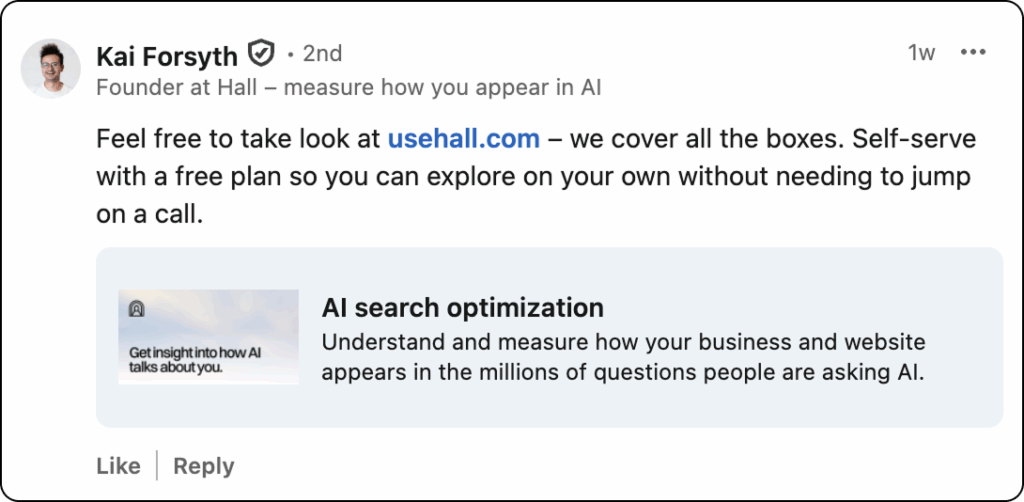
He pitched Hall as covering all our boxes and mentioned it has a self-serve free plan, so we can explore without a sales call. Hall’s value prop: “understand and measure how your business and website appears in the millions of questions people are asking AI.” In short, Hall monitors brand mentions across AI search platforms with an emphasis on being user-friendly.
Community feedback
Hall seems well-aligned with marketers’ needs (especially with that free tier for testing). Having a free plan is a big plus – it lowers the friction to try it out. In our thread, no one had yet tried Hall (aside from the founder’s comment), but given the offer, we suspect many will. We plan to test Hall on a couple of domains to see how it presents data compared to others. For small businesses or those just dipping their toes into AI visibility tracking, Hall could be a great starting point before committing budget to others. It’s positioned as an accessible, AI website visibility tracker that still scales up (they likely have paid tiers for more queries or domains).
11. PromptWatch – Prompt Monitoring with AI Mention Tracking
A more unusual recommendation came from Deian Isac, who asked if we tried PromptWatch.
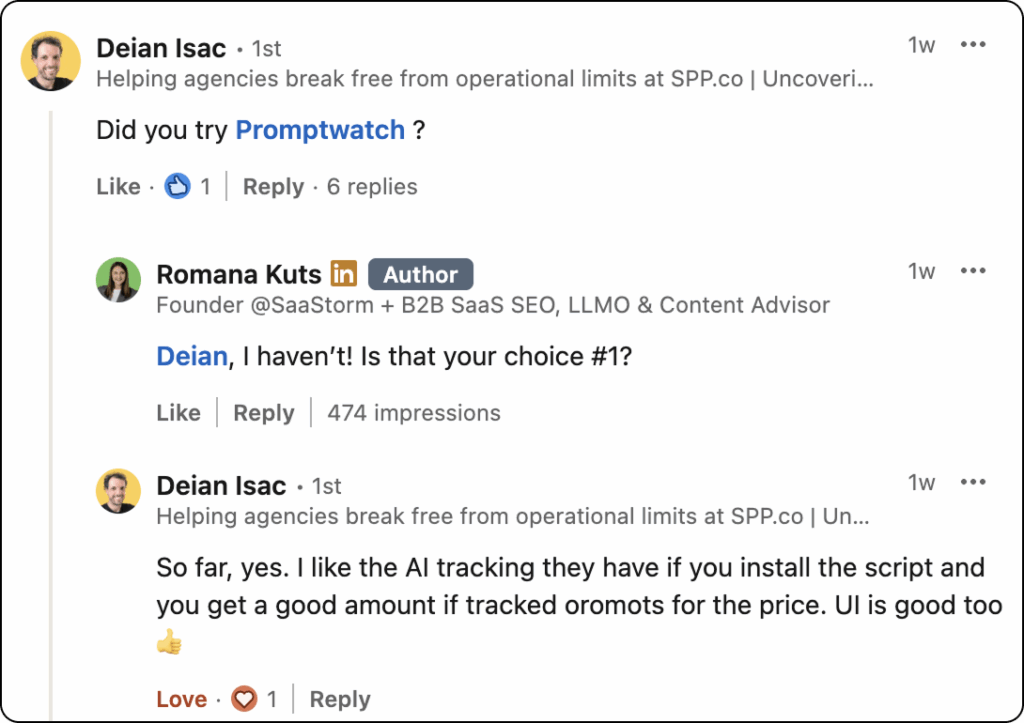
PromptWatch is originally a tool for developers and data scientists to monitor LLM usage (think of it like an observability tool for prompts and outputs). So why mention it here? It turns out some teams have started using PromptWatch or similar tools to track how AI models respond to specific prompts over time – essentially DIY-ing their own brand visibility tracking.
Key features
PromptWatch allows you to log and monitor prompts sent to AI models and their responses. In a marketing context, one could set up a series of prompts like “What’s the best solution for [your category]?” or “[Your Brand] vs [Competitor]” and schedule them to run periodically via the API. PromptWatch would then capture the responses and you could analyze whether your brand appeared, what was said, etc. It’s more of a framework or utility than a ready-made dashboard for AI visibility. However, for technically savvy teams, this approach offers maximum flexibility: you can track any prompt, any model (if you have API access), at whatever frequency, and PromptWatch just helps log it and maybe alert on certain conditions.
12. Waikay – AI Visibility with Actionable Tasks (by InLinks)
Waikay is a tool that came up via Fred Laurent (the founder). Fred highlighted that beyond analytics, “action plans (that work) should also be in priorities” and introduced Waikay.
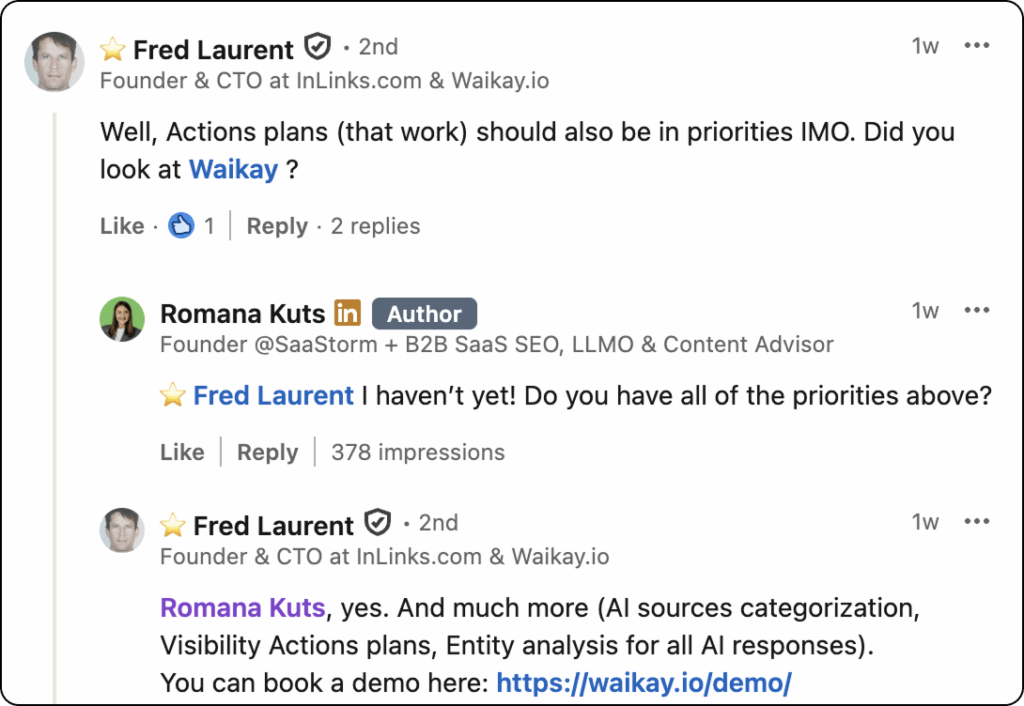
He and a colleague hinted that Waikay does a lot, including AI sources categorization, visibility action plans, and entity analysis for all AI responses.
13. Aiso (getAiso.com) – ChatGPT Query Data and llms.txt Optimization
Another intriguing contender is Aiso, mentioned by Benjamin Tannenbaum.
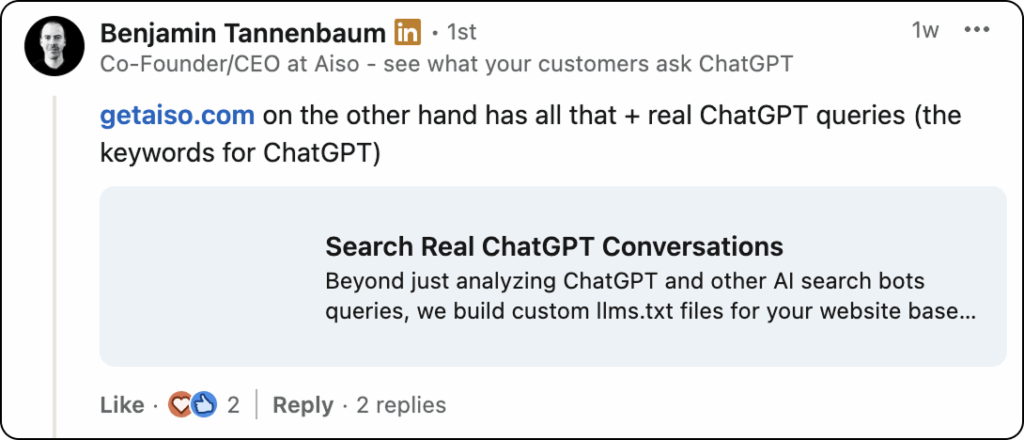
Aiso caught our attention because it claims to have “all that + real ChatGPT queries (the keywords for ChatGPT)”. In other words, Aiso not only tracks your brand’s presence in AI answers, but it also collects actual user questions from ChatGPT and possibly other models.
Community feedback
Benjamin pitched Aiso as going “beyond just analyzing AI search bots’ queries” to actively producing content for LLMs. This suggests Aiso is very forward-leaning – not just tracking, but trying to influence AI outputs with custom content (llms.txt is one way; maybe fine-tuning or feed injection could be others). It sounds almost like an AI-aware content marketing tool. For organizations that want to aggressively optimize for AI, Aiso’s approach is compelling. However, one might ask: where do those “real ChatGPT queries” come from? Privacy and representativeness of that data might be a concern. Nonetheless, we find Aiso’s angle refreshing and will investigate how it gathers and uses conversation data. It addresses a burning question: how to track and analyze patterns in AI visibility from the user demand side (queries) as well as the content supply side (answers). If you are keen on the keywords for AI idea, Aiso could be a unique addition to your toolkit.
14. Other Notable AI Visibility Tracking Tools
Believe it or not, the list above is still not exhaustive. Our LinkedIn commenters alone rattled off a long tail of tools, reflecting just how crowded this space has become. While we won’t deep-dive into each, here are additional AI visibility tracking tools and platforms worth knowing:
- 14. GPTrends: A tool name-dropped as part of an extensive list – likely focuses on trending topics or how your brand trends within AI searches.
- 15. Rankshift: Another in the “heard of it” category; possibly does AI rank tracking or comparisons over time (shifting ranks).
- 16. Anvil (joinanvil.com): A Y Combinator-backed platform aiming to enhance brand visibility in ChatGPT, Gemini, and others. Targets growth and exposure; likely in beta with custom pricing.
- 17. Ansehn: (Spelling might be slightly off) – little info, but included in community lists.
- 18. Rankscale.ai: Highlighted in one blog as “Best for comprehensive AI SEO analysis”. Likely offers a broad feature set similar to AthenaHQ or Hall.
- 19. LLMrefs (llmrefs.com): A dedicated LLM rank tracking tool. It provides live keyword tracking and a proprietary “LLMrefs Score” to grade your content’s visibility. LLMrefs emphasizes showing exactly which websites ChatGPT and other models reference, and includes competitor rank tracking. Pricing is accessible (free tier for 1 keyword, Pro for $79/mo up to 50 keywords). If you prefer a focused LLM rank tracker with scoring, LLMrefs is a solid pick.
- 20. Otterly.ai: Both a product and a blog that’s been covering this domain. Otterly was listed as “Best for AI visibility tracking” in one comparison, and it even published a top-10 list of AI search monitoring solutions (which tells you they consider themselves one). Likely offers a balanced feature set for general use.
- 21. Knowatoa: Mentioned as a top 7 by one blog, possibly focusing on LLM search rank tracking specifically (the name hints at “know AI”?). Might be a smaller tool that does one thing well.
- 22. Nightwatch (AI module): Nightwatch is a traditional SEO rank tracker that apparently added AI monitoring. Their spin is blending SEO and AI tracking in one tool. If you already use Nightwatch for SEO, checking AI results could be convenient there.
- 23. Geostar.ai: One of many “GEO” tools listed by VCs and blogs. Geostar is described as aiming to boost brand recognition in AI-centric search spaces. Typically, such tools offer tracking plus suggestions for optimization.
In evaluating any of these, apply the criteria we discussed. Some will inevitably fold or consolidate; others might become the next Adobe/Google of AI search optimization. For now, early adopters might trial a few of these to see which aligns with their workflow. Just beware of “demo fatigue” – as one expert said, it can feel like endless demos and sales calls trying to compare these tools. When in doubt, start with ones that offer a free trial or transparent pricing, and don’t be afraid to lean on community feedback (as we did).
Conclusion: The Quest for AI Visibility Continues
The sheer number of AI brand visibility tracking methods and tools in 2025 underscores how important – and challenging – it is to track visibility in AI. Much like the early days of web SEO, experimentation is key. Some tools will inevitably provide more accurate or actionable data than others. And as the AI platforms themselves evolve (e.g., new versions of ChatGPT or the rollout of Google’s Gemini), the trackers will need to adapt in real-time.
At SaaStorm, this journey isn’t over. We started with five tools, got flooded with twenty more, and are now actively testing a shortlist that’s expanded to include many of the above. Our decision will come down to what balances comprehensiveness with usability and cost for our clients’ needs. It might even be that we use multiple tools in tandem – for example, one for core tracking and another for deeper analysis – or build our own stopgaps for certain insights.
One clear takeaway: LLM Optimization (LLMO) is real and here to stay. Just as SEO became a staple of digital strategy, we foresee AI visibility tracking becoming a standard practice for content marketers and PR teams. Whether you’re using a scrappy free tool or an enterprise AI SEO suite, the goal is the same – to effectively track and improve your brand’s AI visibility. In an era where chatbots might recommend products or services as often as search engines do, you can’t afford to be invisible or misrepresented in those AI-generated answers.
We hope this overview helps you navigate the landscape. If you’ve been struggling with how to track and analyze patterns in AI visibility for your brand, consider test-driving a few of the tools that sound like a fit. Pay attention to the data quality, the insights you gain, and how easily you can turn those insights into action.
As for us, we’re off to put Scrunch through its paces in a real paid test. We’ll share our experience and final verdict once we’ve had time to see it in action. The AI visibility game is on – and just like classic SEO, it’s equal parts art, science, and experimentation.
Looking for an agency focused on LLMO? Let’s chat!
Schedule a CallFrequently Asked Questions (FAQs)
An LLM (Large Language Model) tracking tool monitors where, how, and how often your brand is mentioned in AI-generated answers across platforms like ChatGPT, Gemini, Bing Chat, and others. Traditional SEO rank trackers only track web search results, not AI chatbot responses – so if you want to ensure your brand is visible and accurately represented in the AI-driven future of search, LLM tracking tools are essential.
Most tools simulate or automate AI queries using a set of prompts and then analyse the responses to see if your brand is mentioned, how it’s positioned, and which sources are cited. Some use official APIs, others use scraping or third-party data. Advanced tools aggregate results, track performance over time, and even provide competitor benchmarks or sentiment analysis.
Absolutely. Many agencies and in-house teams use a combination of LLM tracking tools to balance core tracking, deep analysis, and specific features (like sentiment or competitor benchmarking). Testing multiple tools can also help you identify which works best for your unique needs and workflow.


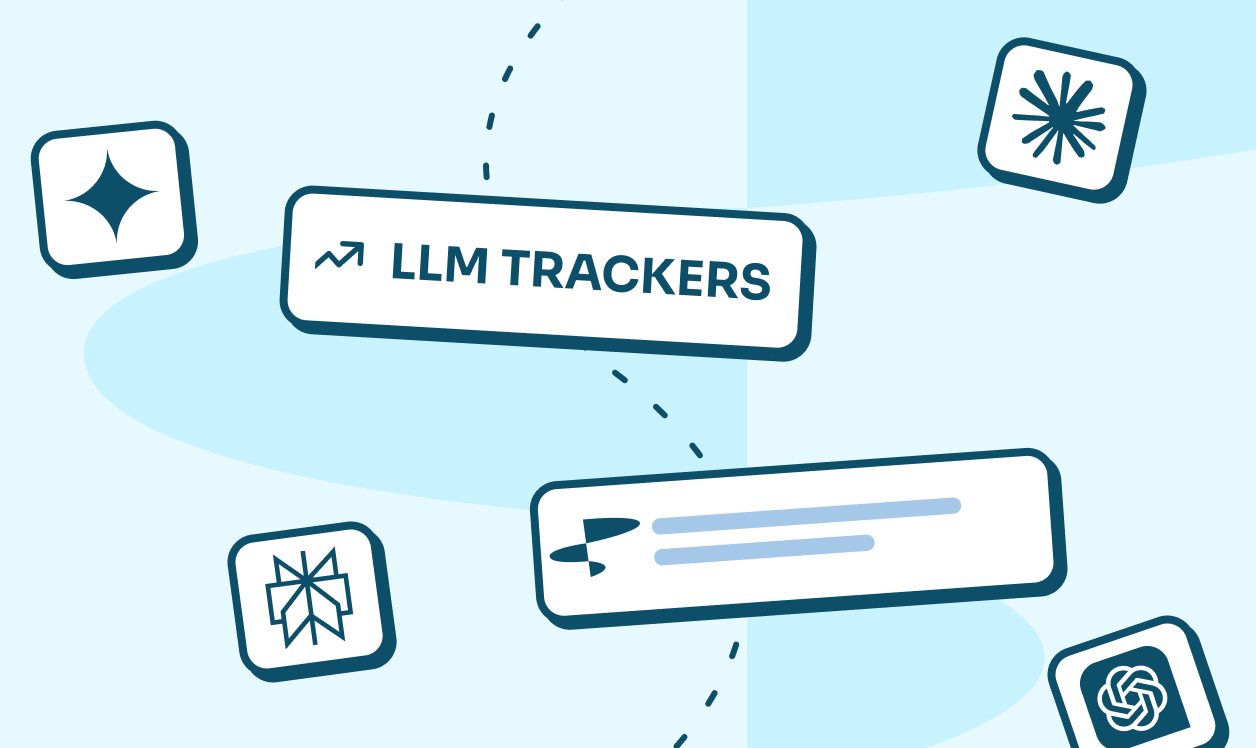
 SaaStorm experts in your inbox.
SaaStorm experts in your inbox.


